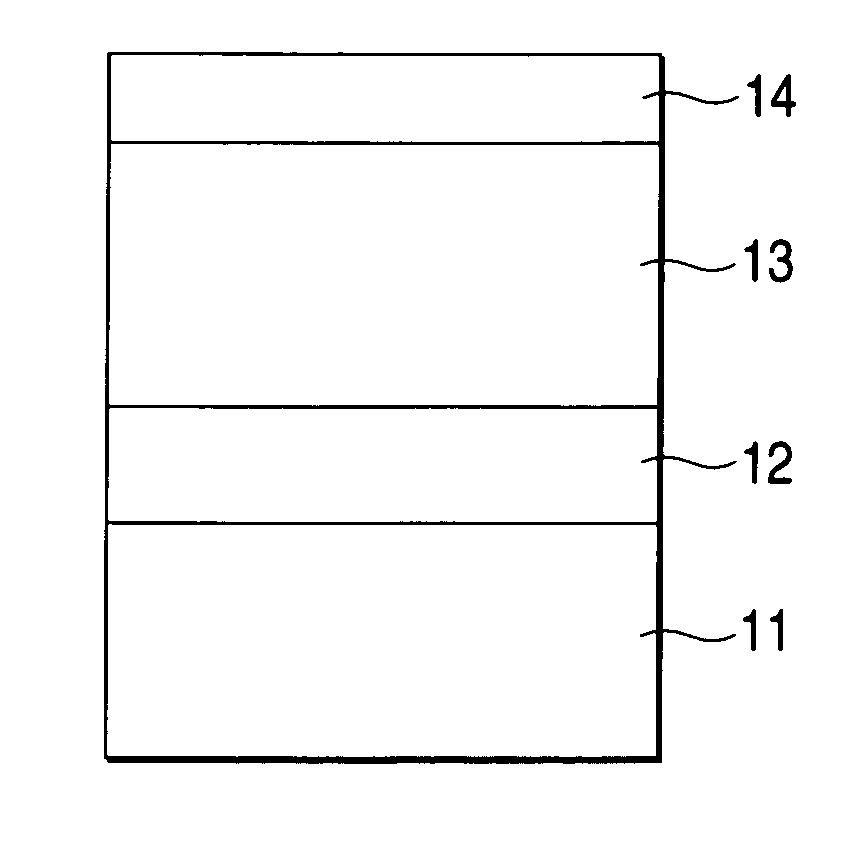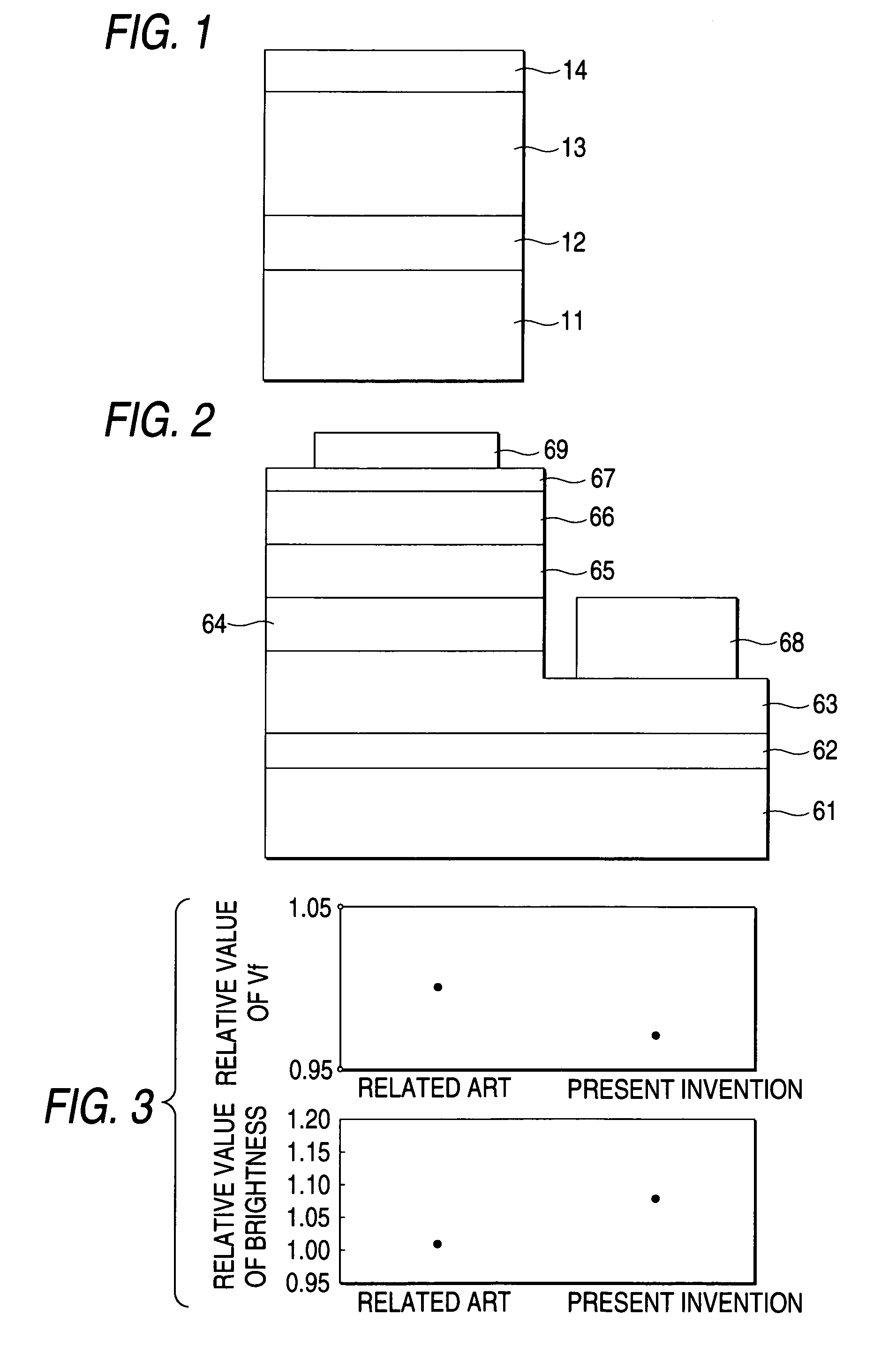Method for producing p-type group III nitride compound semiconductor
a nitride compound and semiconductor technology, applied in semiconductor devices, lasers, semiconductor lasers, etc., can solve the problems of increasing the drive voltage and the inability to obtain ohmic junctions in consideration of ohmic contact with metal, so as to reduce resistance and improve the percentage of activated p-type impurities in the first group iii nitride compound semiconductor layer.
- Summary
- Abstract
- Description
- Claims
- Application Information
AI Technical Summary
Benefits of technology
Problems solved by technology
Method used
Image
Examples
embodiment 1
[Embodiment 1]
[0027]Embodiment 1 shows the case where impurities are not added to the second Group III nitride compound semiconductor layer. FIG. 1 is a view typically showing the configuration of this embodiment. Specifications of respective layers are as follows.
[0028]
LayerComposition (Impurities)Second Group III nitride compoundGa0.85In0.15Nsemiconductor layer 14First Group III nitride compoundGaN (Mg)semiconductor layer 13Buffer layer 12AlNSubstrate 11sapphire
[0029]First, a sapphire substrate cleaned well was put on a susceptor in an MOVPE apparatus (hereinafter referred to as “reactor”). After the reactor was evaluated to a vacuum, a surface of the sapphire substrate was etched and cleaned at 1050° C. for 20 minutes while a hydrogen gas was made to flow into the reactor. Then, the substrate temperature was decreased to 400° C. and a 30 nm-thick AlN buffer layer was grown on the substrate while a TMA (trimethyl aluminum) gas as an Al source, an ammonia gas as an N source and a h...
embodiment 2
[Embodiment 2]
[0034]Embodiment 2 shows the case where n-type impurities are added to the second Group III nitride compound semiconductor layer. At the time of growth of the Ga0.85In0.15N layer as the second Group III nitride compound semiconductor layer after the growth of the Mg-doped GaN layer as the first Group III nitride compound semiconductor layer in Embodiment 1, an SiH4 (silane) gas was made to flow along with the TMI gas, the TMG gas, the ammonia gas and the nitrogen gas to thereby add Si as n-type impurities to the Ga0.85In0.15N layer.
[0035]Holes in the Mg-doped GaN layer as the first Group III nitride compound semiconductor layer subjected to electron beam irradiation in the same manner as in Embodiment 1 were measured. A result of the measurement was substantially the same as in Embodiment 1 and exhibited very excellent characteristic compared with the related art.
embodiment 3
[Embodiment 3]
[0036]Embodiment 3 shows the case where n-type and p-type impurities are added to the second Group III nitride compound semiconductor layer. At the time of growth of the Ga0.85In0.15N layer as the second Group III nitride compound semiconductor layer after the growth of the Mg-doped GaN layer as the first Group III nitride compound semiconductor layer in Embodiment 1, an SiH4 (silane) gas and a DEZ (diethyl zinc) gas were made to flow along with the TMI gas, the TMG gas, the ammonia gas and the nitrogen gas to thereby simultaneously add Si as n-type impurities and Zn as p-type impurities to the Ga0.85In0.15N layer.
[0037]Holes in the Mg-doped GaN layer as the first Group III nitride compound semiconductor layer subjected to electron beam irradiation in the same manner as in Embodiment 1 were measured. A result of the measurement was substantially the same as in Embodiment land exhibited very excellent p-type characteristic compared with the related art.
PUM
| Property | Measurement | Unit |
|---|---|---|
| thickness | aaaaa | aaaaa |
| thickness | aaaaa | aaaaa |
| temperature | aaaaa | aaaaa |
Abstract
Description
Claims
Application Information
 Login to View More
Login to View More - R&D
- Intellectual Property
- Life Sciences
- Materials
- Tech Scout
- Unparalleled Data Quality
- Higher Quality Content
- 60% Fewer Hallucinations
Browse by: Latest US Patents, China's latest patents, Technical Efficacy Thesaurus, Application Domain, Technology Topic, Popular Technical Reports.
© 2025 PatSnap. All rights reserved.Legal|Privacy policy|Modern Slavery Act Transparency Statement|Sitemap|About US| Contact US: help@patsnap.com


